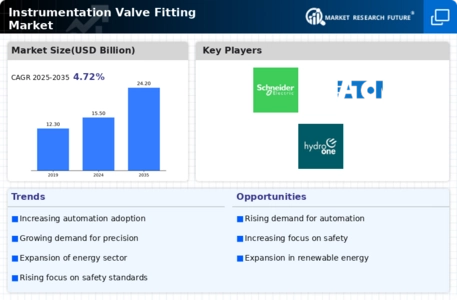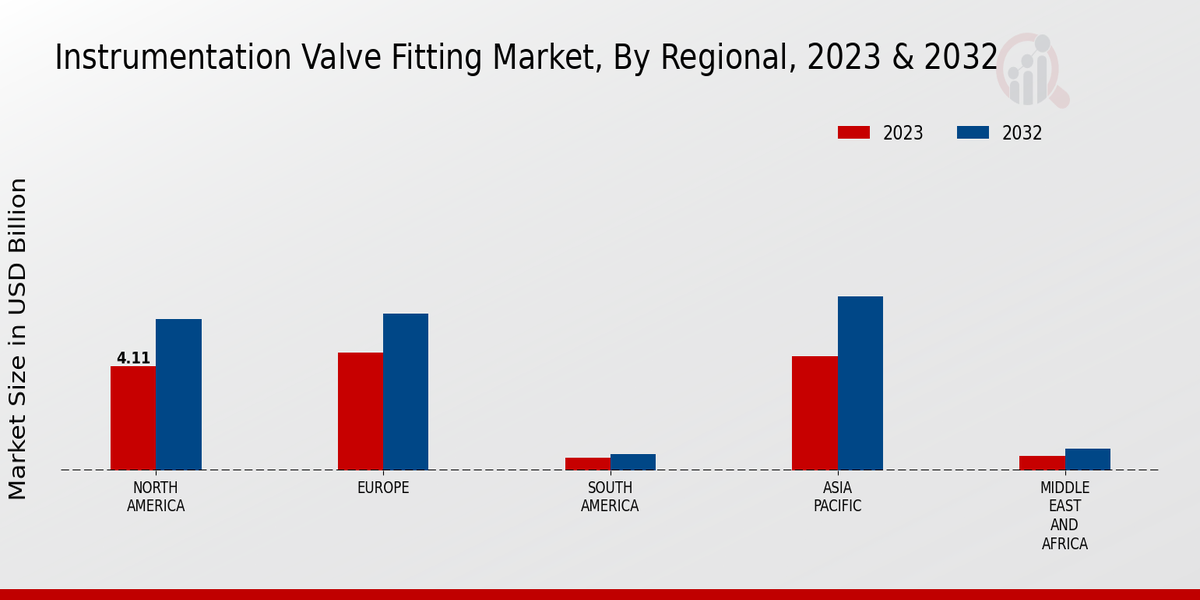Market Growth Projections
The Global Instrumentation Valve Fitting Market Industry is projected to experience robust growth over the coming years. The market is anticipated to reach a value of 15.5 USD Billion in 2024, with expectations to expand to 24.2 USD Billion by 2035. This growth trajectory indicates a compound annual growth rate of 4.13% from 2025 to 2035. Such projections reflect the increasing adoption of advanced technologies, the rising demand for automation, and the expansion of key sectors such as oil and gas. The market's growth is indicative of the broader trends in industrial automation and the need for reliable fluid control solutions.
Rising Safety Regulations
The rise in safety regulations across various sectors is a crucial driver for the Global Instrumentation Valve Fitting Market Industry. Governments and regulatory bodies are enforcing stringent safety standards to mitigate risks associated with fluid handling and processing. This trend compels industries to invest in high-quality instrumentation valve fittings that meet these regulations. For instance, the oil and gas sector, which is heavily regulated, requires robust valve fittings to ensure safe operations. As compliance becomes a priority, the demand for reliable and certified valve fittings is expected to surge, contributing to the overall market growth.
Technological Advancements
Technological advancements in instrumentation valve fittings are significantly influencing the Global Instrumentation Valve Fitting Market Industry. Innovations such as smart valves equipped with sensors and IoT capabilities enhance monitoring and control, providing real-time data for better decision-making. These advancements not only improve operational efficiency but also ensure compliance with stringent safety regulations. For example, the integration of predictive maintenance technologies allows for timely interventions, reducing downtime and maintenance costs. As industries increasingly adopt these advanced technologies, the market is likely to see substantial growth, driven by the need for improved performance and reliability in fluid control systems.
Growing Demand for Automation
The increasing demand for automation across various industries is a primary driver of the Global Instrumentation Valve Fitting Market Industry. As industries strive for enhanced efficiency and reduced operational costs, the integration of automated systems becomes essential. Automation requires precise control of fluids and gases, which instrumentation valve fittings facilitate. For instance, sectors such as oil and gas, pharmaceuticals, and food processing are increasingly adopting automated processes, leading to a projected market value of 15.5 USD Billion in 2024. This trend is expected to continue, with the market potentially reaching 24.2 USD Billion by 2035, reflecting a compound annual growth rate of 4.13% from 2025 to 2035.
Expansion of Oil and Gas Sector
The expansion of the oil and gas sector is a significant driver of the Global Instrumentation Valve Fitting Market Industry. As exploration and production activities increase globally, there is a heightened need for reliable valve fittings to manage the flow of hydrocarbons safely and efficiently. The sector's growth, particularly in emerging markets, necessitates advanced instrumentation solutions to enhance operational efficiency and safety. This demand is reflected in the projected market value, which is anticipated to reach 15.5 USD Billion in 2024 and grow to 24.2 USD Billion by 2035, driven by the ongoing investments in infrastructure and technology.
Increasing Focus on Energy Efficiency
The increasing focus on energy efficiency is driving growth in the Global Instrumentation Valve Fitting Market Industry. Industries are under pressure to reduce energy consumption and minimize waste, leading to the adoption of advanced valve fittings that optimize fluid flow and reduce leakage. This trend is particularly evident in sectors such as manufacturing and utilities, where energy costs significantly impact profitability. By implementing energy-efficient solutions, companies can achieve substantial cost savings and enhance their sustainability profiles. As a result, the demand for innovative instrumentation valve fittings that support energy efficiency initiatives is expected to rise, further propelling market growth.















Leave a Comment